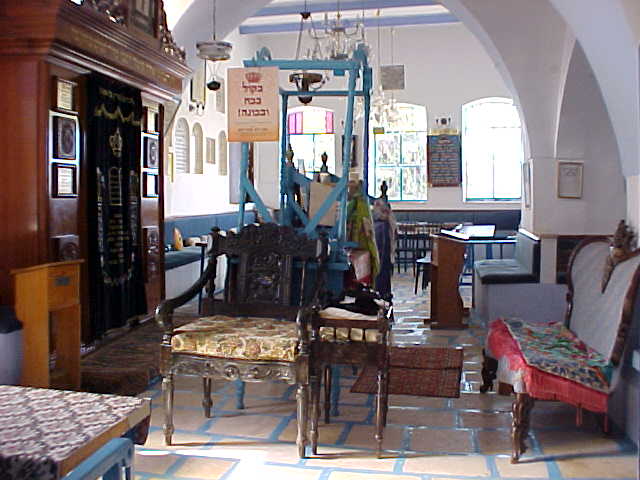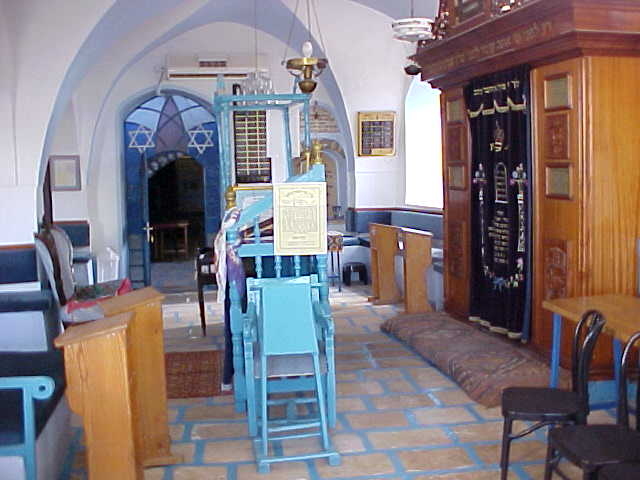by Chana Katz
When the great earthquake of 1837 began its deadly rumble, the men of Safed were just gathering in their houses of worship for afternoon prayers.
At the Avreitsh Synagogue, the holy Rav Avraham Dov Auerbach screamed: Come to me!”
In a split second the men standing in the western half of the synagogue ran to the eastern half and huddled around the Rebbe, who prostrated himself near the bima and cried out to G-d for mercy.
As the very beams and walls ferociously shook around them, the men watched as the half of the synagogue — where they had been standing seconds earlier — collapsed in rubble. Their half remained intact; they had been spared the death that swallowed up a full ninety percent of Safed’s population and almost all of her once-splendid synagogues and buildings.
Now and Then
Like almost all of the famous synagogues in Safed, the Avreitsh has been restored. But unlike many other synagogues which are open for daily prayer services, the Avreitsh is opened only for Shabbat and holiday services, and at that, the shul manager says he has to go “knocking door to door” to round up members of the minyan.
Sparsely used and a little difficult to find, this off-the-path synagogue by Alkabetz Street on the “Madregot HaMikubalim” – “The Stairs of the Kabbalists” – is far from forgotten. To mark the 161st year since the passing of the Avreitsher Rebbe on the 12th of Kislev, more than 200 guests recently gathered at the synagogue. They recalled the strength and courage of the great Chassidic leader who came to Safed in the early 1800s and steered it through some of its most devastating moments, including the earthquake, brutal Druze massacres and deadly plagues.
Caretakers: A Family Affair
The synagogue’s current gabbai (caretaker/manager), Meir Meiri, says that while the synagogue cannot afford to have someone remain in the synagogue all day to greet visitors, that he will be willing to open the synagogue to groups of four or more. If you do get him to unlock this piece of Safed’s mystical history, he may give you many glimpses into his own families centuries-old history — from the time Rav Avreitsh appeared to his father in a dream to the time he got a bullet in the back in the 1948 War of Independence.
After four members of Meiri’s family were murdered by Arabs, his family closed off their huge house — once inhabited by 600 family members (talk about extended family living!) and moved close to the synagogue in a one-room flat. Their first night there, Meiri said, Rav Avreitsh came to his father, Shlomo, in a dream and asked him to come to pray in and strengthen his neglected synagogue. Rav Avreitsh told Shlomo in the dream that this service would lead to a healing of his poor physical health. The next day his father began to attend to the shul, restoring its interior and becoming its gabbai for 13 years. After that, Shlomo’s brother, who is the father of Safed’s current mayor, became gabbai, and in recent years the mantel was passed to Meir Meiri.
Interesting Objects
Some special points of interest in this synagogue include the original Torah scroll that was read by the Avreitsher. Nowadays it is taken out only on Rosh Chodesh and holidays but it shares space in the aron hakodesh (‘Holy Ark’) with 13 other Torah scrolls, including some that were brought from Iran and are more than 300 years old. Originally an Ashkenazic synagogue in accordance with the traditions from the Ukranian town of Avreitsh where Rav Avraham Dov had been Rebbe for 40 years before coming to Safed, the synagogue has taken on Sephardic customs since 1948. Note the beautiful Persian cases enclosing the Torah scrolls, brought to Safed centuries ago.
Avreitsh where Rav Avraham Dov had been Rebbe for 40 years before coming to Safed, the synagogue has taken on Sephardic customs since 1948. Note the beautiful Persian cases enclosing the Torah scrolls, brought to Safed centuries ago.
The large wooden chair with intricate carvings for brit milah ceremonies was also brought from Iran by Meiri’s great-grandfather. It is near the original “loveseat” sofa that was used for the performance of ritual circumcisions by the Rebbe himself.
Also intact, according to Meiri, are the original chair and “shtender” from which the Rebbe prayed.
A new aron kodesh has been built in order to accommodate the many Torah scrolls housed in this synagogue, but the original one used by Rav Avraham Dov has also been kept in the synagogue.
Equal Opportunity
While it may be a difficult task to compare and contrast the beauty of Safed’s numerous ancient synagogues, there is at least one factor that clearly distinguishes the Avreitsh Synagogue from all the others — besides its miraculous survival of the earthquake.
That is the simple list on the wall making note of anyone who contributes to the synagogue. While public plaques and recognition in so many of the world’s synagogue’s today are reserved for the major donors, the simple piece of paper on the wall of the Avreitsh Synagogue lists the smallest donor upwards.
Thus, if one looks very close, he will notice that the family that donated 1,400 shekels last year, is listed below the man who donated eight shekels (about $2)!
If one is only passing by the synagogue but has no time to enter or track down Meir Meiri, a box on its outside wall has a slot for the visitor to leave notes. Every month before Rosh Chodesh, Meiri takes the letters to the grave of Rav Avraham Dov in the Old Cemetery of Safed. His telephone number may be obtained through ASCENT.
Buy books about Safed and the ancient masters of Kabbalah at the Kabbala Online Shop.
Chana Katz, a former South Florida journalist, lives in Tsfat. Her articles on life in Israel have reached publications throughout the world.

